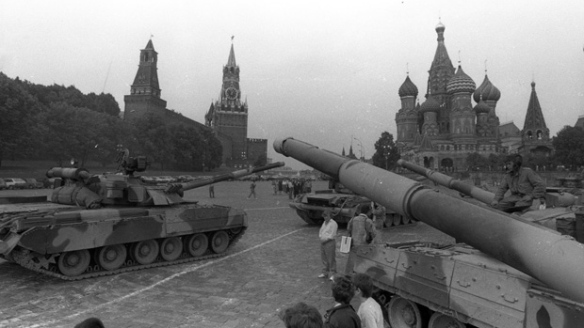T-80UD tanks in the red square during the 1991 coup d’etat attempt
The centrifugal forces unleashed by glasnost and perestroika were unmistakably tearing apart the fabric of the Soviet Union, causing economic and social turmoil, and destroying the place of the army in politics and society. In response to Gorbachev’s sometimes unwillingness and other times inability to stop the disintegration a cabal of ultraconservatives plotted to overthrow him for the purpose of restoring the power of the party, the army, and the Russian nationality over the rest of the Union.
The Soviet Army’s involvement in the August 1991 coup against Gorbachev can be traced to Minister of Defense Iazov. The head of the conspiracy to create the State Committee for State Security, KGB chief Kriuchkov, knew that without the army the revolt had no chance and therefore enlisted the reluctant participation of Iazov whose main thought was to preserve the disintegrating Soviet empire. Only through his influence were other important generals such as commander of army ground forces General Varennikov, Deputy Defense Minister Achalov, commander of the Airborne forces General Grachev, and commander of the Air Force General Shaposhnikov brought into the scheme. Most of these men had serious doubts about the coup and for a time acted only out of a sense of loyalty to their immediate superior – Iazov. Acting under the orders of Varennikov and Grachev, elements of two army tank divisions and some airborne units dutifully rolled into Moscow on 19–20 August with quite vague instructions and no clear mission.
Iazov was caught off guard, because the people of Moscow, like the peoples of the Caucasus, did not back down from confrontation with the army. Instead, it was the soldiers who proved irresolute; and like in Novocherkassk in 1962, the generals were unwilling to order shooting. Because the people of Moscow were unintimidated, Iazov, fearing to create a civil war, and on the advice of his generals, decided on 21 August to withdraw the troops from Moscow, whereupon the coup collapsed.
Marshal Sergei Akhromeev, personal military advisor to Gorbachev, and Chief of the General Staff until 1988, committed suicide by hanging himself in his Kremlin office shortly after the failed coup attempt. His suicide note included the following sentiment shared by many top-ranking officers, “everything I have devoted my whole life to building is collapsing.” Subsequently Gorbachev named Marshal of Aviation E. I. Shaposhnikov the new Minister of Defense. He promptly resigned from the Communist Party, dismissed General Moiseev, the Chief of Staff of the Army, for “compromising” himself during the coup, and purged the Ministry of Defense of the majority of its deputy ministers and heads of departments and administrations.
The failure of the coup resulted in the virtual death of the Communist Party in the USSR and the abolition of GlavPUR in the army. Three days after the coup Gorbachev, in a Presidential decree, announced the termination of the activity of political parties and political movements in the armed forces. Military personnel could participate in political parties and movements on their own time. A week later the Ministry of Defense officially abolished GlavPUR. Political personnel who wanted to stay in the armed forces could petition to be transferred to military-educational duties. Overall, though, many were discharged, especially those of higher rank. The army ordered all former GlavPUR personnel who had twenty-five or more years of service discharged by 1 December 1991. That amounted to more than 3,000 political workers. Shaposhnikov promised that only five or six of GlavPUR’s thirty-two generals would remain in service.
Boris Yeltsin’s ascendancy to the leadership of a new Russia and the formal dissolution of the Soviet Union in December 1991 saw to the final demise of the Soviet Army and its immediate resurrection as a restructured Russian Army built on the shaky foundations of its predecessor.
